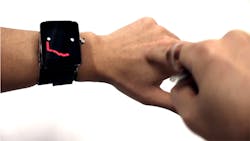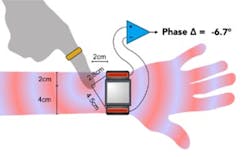Could 'Skin-to-Screen' Tech Lead to Smartwatch Revolution?
Like trying to remain friends with your ex, smartwatches sound like a really good idea: You can do most of the stuff you can with your smartphone, but not the things that really matter, and it’s usually awkward.
Luckily, the brilliant researchers at Carnegie Mellon University, led by the Future Interface Group's Chris Harrison, recently announced a game-changing technology called SkinTrack that will help you rekindle your old relationship – with your watch. Using a high-frequency emitting ring and a wristband embedded with two pairs of electrodes, the application turns your finger into a stylus and your arm into a touch pad.
“The problem with smartwatches and wearables is their screen real estate is really small,” says Gierad Laput, a third-year PhD student at CMU’s Human-Computer Interaction Institute who worked on the project. “If you can extend that screen functionality to other surface areas, in this case, the skin, that would be really good.”
This “skin to screen” technique extends your operating surface from a tiny 2-in. square to arm’s length, and will decipher touching, swiping, and continuous tracking motions on your forearm or hand. This allows you to doodle, dial, type,and even play "Angry Birds" on your arm, and your smartwatch interprets it as it was part of its own touchscreen.
So how does it work?
“When the user touches their skin, that signal travels from the ring across the human arm, which is conductive,” says Laput, who developed the software and machine learning side of SkinTrack.
Yang Zhang developed the hardware, including the 18-Mhz emitting ring, and the wristband, which uses the electrodes to triangulate position.
“It’s kind of like how GPS figures out where you are or cell towers figure out where you are based on time of arrival,” Laput explains. “Here the electrodes are sensitive to the X and Y direction. Once you have that, through machine learning, you can figure out where the finger is using those two techniques.”
Your finger's location on your arm produces varying phase differences, which the electrode pairs pick up and use to triangulate position.
Source: Human-Computer Interaction institute/CMU
Laput, an electrical engineer, says that the longer you use it, the better the performance becomes. He hopes this will not only make smartwatches a lot more usable, but also help transform your arm into a sensor, forming an ultimate connection to the Internet of Things.
“We want this to help users look at smartwatches in a completely different way,” he says.
This could have a huge impact in industrial environments.
“If you’re in a very constrained environment, like a factory, every second counts,” Laput says.
It’s easier to tap on your arm, then reach into your pocket for your smartphone or sensing device, especially if you’re wearing a harness or tool belt. Laput says that the technology will still work with certain gloves, and the phase detection can also work through sleeves.
“Hopefully industry will take a look at what we do and say these are really cool inventions, and this might potentially be one of the killer applications for smartwatches to take off,” Laput says.
Laput has also done extensive work into electromagnetic sensing, which could really lead the next evolution of wearable technology: “Our vision is to turn any surface into a touch pad, and we’re working on that as the next step,” he says.
Preliminary research indicates this technology could also prove beneficial augmented and virtual realities, though Laput was not at liberty to release any details except to say the research was “promising.” An update on that front could come as early as the end of the year.
As for this technology finding its way to the factory floor, it could be longer than five years to commercialize and scale, Laput predicts. Until then, expect a frustrating love affair with your current smartwatch.
About the Author
John Hitch
Editor, Fleet Maintenance
John Hitch, based out of Cleveland, Ohio, is the editor of Fleet Maintenance, a B2B magazine that addresses the service needs for all commercial vehicle makes and models (Classes 1-8), ranging from shop management strategies to the latest tools to enhance uptime.
He previously wrote about equipment and fleet operations and management for FleetOwner, and prior to that, manufacturing and advanced technology for IndustryWeek and New Equipment Digest. He is an award-winning journalist and former sonar technician aboard a nuclear-powered submarine where he served honorably aboard the fast-attack submarine USS Oklahoma City (SSN-723).


